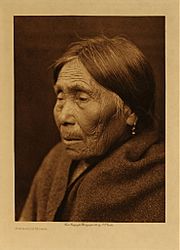Chimakum facts for kids

A Chimakum woman,
photographed by Edward S. Curtis |
|
| Total population | |
|---|---|
| unknown | |
| Regions with significant populations | |
| United States (Washington) | |
| Languages | |
| English, formerly Chemakum | |
| Related ethnic groups | |
| Quileute |
The Chimakum people, also known as Chemakum, were a Native American group. They lived in the northeastern part of the Olympic Peninsula in Washington state. Their homes were between Hood Canal and Discovery Bay.
Their main villages were around Port Townsend Bay and Port Ludlow Bay. Today, people who are descendants of the Chimakum are part of three federally recognized tribes: the Skokomish, Jamestown S'Klallam, and Port Gamble S'Klallam tribes.
Contents
Who Were the Chimakum People?
The Chimakum people, also called the Aqokúlo, lived in what is now Washington state. They were a small group, and their population became very low by the early 1900s.
In 1780, there were about 400 Chimakum people. By 1855, this number had dropped to about 90. A census in 1910 found only three people who still spoke the Chimakum language, and they didn't speak it perfectly. Today, some people identify as Chimakum or as descendants of the Chimakum.
What Language Did They Speak?
The Chemakum language was a unique language spoken by the Chimakum people. It was one of two Chimakuan languages and was quite similar to the Quileute language. Sadly, the Chemakum language is now extinct. It was spoken until the 1940s in the area between Port Townsend and Hood Canal.
The name Chimakum comes from a Salishan word for the Chimakum people. In 1890, a famous anthropologist named Franz Boas found only three people who could still speak the Chemakum language. They didn't speak it perfectly, which shows how rare it had become.
The Chimakum language was very different from the languages spoken by their neighbors. Other tribes sometimes said the Chimakum "speak like birds" because their language was hard to understand. This language barrier sometimes made it difficult for the Chimakum to trade or interact with other tribes.
Franz Boas, who studied many Native American languages, learned over 1200 Chimakum words from a tribal member named Louise. Louise could speak both Clallam and Chimakum, which helped Boas record the language.
A Look at Chimakum History
According to stories from the Quileute people, the Chimakum were once part of their group. The story says that a great flood carried the Chimakum in their canoes through the Olympic Mountains to the other side of the Olympic Peninsula. Scientists believe the last big floods in this area happened about 3000 years ago.
Around 1789, there were about 400 Chimakum people living on the Quimper Peninsula and along Hood Canal. At that time, they were involved in conflicts with several other tribes. These included the Snohomish, Snoqualmie, Klallam, Makah, and Ditidaht tribes.
Conflict with the Suquamish
In 1847, the Chimakum faced a very difficult conflict with the Suquamish tribe. This event greatly reduced the Chimakum population. The Suquamish decided to go to war because of ongoing tensions and specific events.
Chief Seattle, for whom the city of Seattle is named, led the Suquamish in this conflict. About 150 Klallam warriors also helped the Suquamish. The Chimakum people were eventually cornered in one village. This village, called Tsetsibus, was located near Chimakum Creek, close to what is now Irondale.
The Suquamish warriors hid near the village and waited for a chance to attack. When many Chimakum villagers left to help a family outside, the Suquamish rushed into the village from behind. They surprised the Chimakum inside the village and attacked. Many Chimakum people were killed or captured. Women and children were taken away. Chief Seattle's oldest son was one of the few Suquamish who died in this fight.
The few Chimakum who survived, including their main chief, later joined the Twana, or Skokomish, at the head of Hood Canal.
Treaties and Land Claims
The Chimakum people did not want to leave their traditional lands. However, in 1855, the Twana and Chimakum, along with the Klallam, signed the Point No Point Treaty. This treaty created a reservation at the mouth of the Skokomish River. One of the Chimakum leaders who signed the treaty was Chief Kulkakhan, also known as General Pierce.
The treaty asked the Klallams to move to the Skokomish Reservation, but most did not. Later, in 1936–37, the government created Klallam reservations for the Lower Elwha and Port Gamble communities. The Jamestown community was not officially recognized until 1981.
The Klallams later asked for more payment for the lands they gave up in the Point No Point Treaty. They argued that the Chimakum were almost gone by the time of the treaty and that the remaining Chimakum had joined the Klallam tribe. The Klallams had taken over the former Chimakum lands. In 1957, the government agreed with the Klallam's claim to the Chimakum lands and gave them over $400,000 in payment.
Places Named After the Chimakum
Several places in Washington state are named after the Chimakum people. These include Chimakum Creek and the town of Chimacum, Washington, both located in the Chimacum Valley. There is also a Washington State Ferry named the M/V Chimacum.

